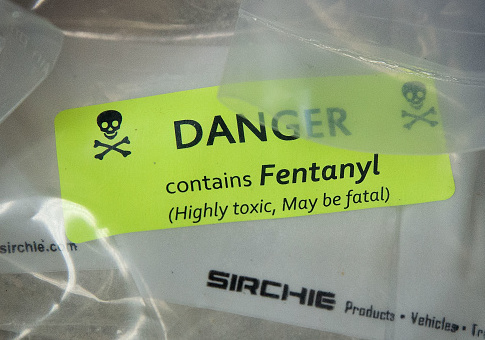A bevy of chemists, law enforcement officers, and medical experts appeared before a meeting of the United States Sentencing Commission Tuesday to provide testimony on the emerging health and justice threat posed by synthetic drugs.
The meeting, focused on fentanyl and so-called synthetic cannabinoids, was the third such hearing that the Sentencing Commission has held on the topic of synthetic drugs. The Commission is responsible for setting advisory guidelines for sentencing in the federal criminal justice system; 46 percent of federal inmates are incarcerated for drug offenses, the most common reason for incarceration.
Synthetic drugs, usually the work of illicit chemists, are distinguished from drugs like heroin and marijuana produced by more traditional farming approaches.
"The concept of synthetic is if it's man-made, versus something that is homegrown," Dr. Roger Mitchell, chief medical examiner of the District of Columbia, told the Free Beacon. "So heroin is not necessarily synthetic because it's made out of poppy, it's manufactured out of a natural construct. Marijuana isn't synthetic."
Importantly, synthetic drugs allow drug traffickers to avoid blanket bans on certain kinds of drugs otherwise scheduled under the Controlled Substances Act by making minor changes to the chemical structure of the drug they want to sell.
"Currently, traffickers are again exploiting available legitimate research information on structure activity relationships, making small changes to the chemical structure of fentanyl and distributing these fentanyl analogues in the illicit drug market," explained Dr. Michael van Linn, a drug scientist with the DEA.
The opioid fentanyl—50 to 100 times stronger than morphine—and its analogues make up the deadliest synthetic drugs, responsible for more than 20,000 deaths in 2016.
Chemists speaking to the Sentencing Commission explained the proliferation of fentanyl analogues, designed to dodge regulations. Those analogues include drugs like carfentanyl, used as an elephant tranquilizer, just 50 micrograms of which constitutes a lethal dose, and ocfentanyl, which is 6,300 times stronger than morphine.
Last month, the DEA took action to fight the spread of fentanyl analogues, preemptively scheduling all such drugs under the Controlled Substances Act and easing the burden faced by federal prosecutors.
Synthetic drugs are not new, but they have taken off in recent years. Data released on Tuesday by the Customs and Border Protection agency highlighted the rise of synthetic drugs in transnational drug trafficking.
As much was reflected in the testimony of many of the experts. Major Juan Colon of the New Jersey State Police explained that the use of Naloxone (a.k.a. Narcan, a drug used to reverse opioid overdoses) had risen from 5,000 instances in 2014 to over 12,000 in 2017, largely thanks to fentanyl. Robert Perez, representing the CBP, confirmed that fentanyl was the most commonly seized drug in 2017.
The rise in popularity of synthetic opioids is partially attributable to their relative cheapness. Dr. Howard Haft, a Deputy Secretary for Public Health of Maryland, noted that the cost of a kilogram of fentanyl is just $2,000, far cheaper than an equivalent mass of heroin, and far more lucrative—moving that kilogram of fentanyl could result in a profit of $5 to $10 million to the dealer.
Fentanyl is also easier to acquire. "Fentanyl can discretely be purchased via the dark web and delivered via legitimate parcel services," Colon explained.
The impact of synthetic opioids is felt not only by first responders and police, but also by addicts. Mitchell, the D.C. medical examiner, explained how the primary source of overdose deaths in his jurisdiction were older men who had been using heroin for decades. When fentanyl was added to the drug supply by dealers, overdose deaths shot up—overdose deaths have risen from 80 or so a year to over 230.
"Fentanyl is the culprit," Mitchell said.
Less deadly, but still concerning to public health and law enforcement experts, are synthetic cannabinoids. Marketed as "legal weed," these drugs contain concentrations of THC (tetrahydrocannabinol) far higher than grown marijuana.
The resultant symptoms are disturbing: convulsions, agitation, elevated heart rate, vomiting, seizures, coma, and in some cases, death.
"The consequences of ingesting these chemicals is a pathway to addiction with debilitating and often long lasting side effects, as well as the possibility of death," said Dr. Jordan Trecki, a pharmacologist with the DEA.
Concerns are further exacerbated by the marketing targets of synthetic cannabinoids: children, recovering addicts looking to pass a "pee test," and the homeless. Children are especially vulnerable, with brightly colored packaging and familiar characters–Dr. Trecki's testimony included images of so-called "scooby snax," emblazoned with the face of Scooby Doo and coming in "flavors" like green apple and strawberry smash.
The on-the-ground results are tragic. Joseph Schleigh, the acting chief of the DEA's synthetic drugs and chemicals section, told the story of a sixteen-year-old boy who, while high on synthetic cannabinoids, drove his truck into a train and died. Matthew Barber, a detective from Lubbock, Texas, explained how synthetic cannabinoids have turned a local park into "zombie park," where hooked homeless people wander in a haze, posing a safety threat to the public and emergency responders.
Both fentanyl and synthetic cannabinoids pose a challenge for border enforcement especially, insofar as they are primarily produced abroad, in China. The Department of Justice recently announced the first ever indictment of Chinese traffickers, calling for the arrest of two fentanyl distributors based out of that country.
However, according to Schleigh, the blight is unlikely to abate any time soon.
"Synthetic cannabinoids, and opioids, including synthetic opioids such as fentanyl and fentanyl analogues, will continue to pose a nationwide threat for the foreseeable future," he said. "The United States will likely continue to see overdoses and deaths as a result of synthetic drug use, although DEA and its federal, state, and local partners are working hard to reduce those numbers."
